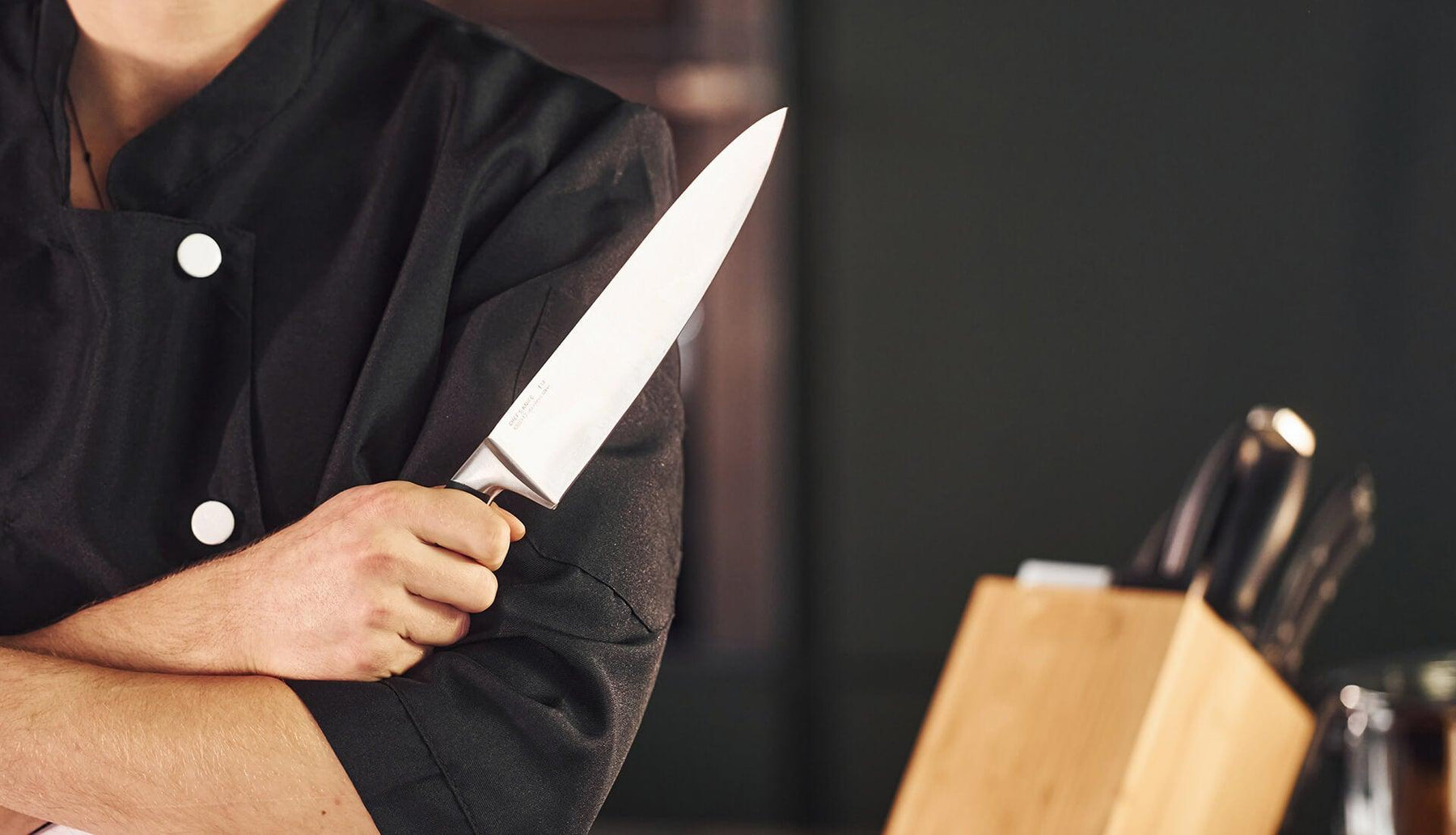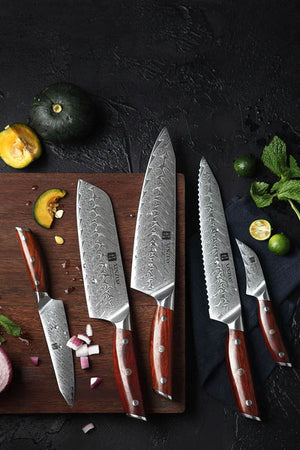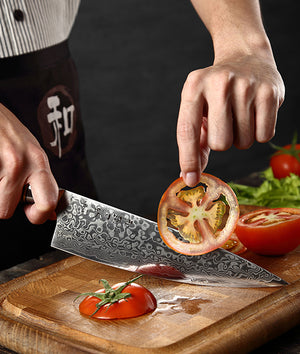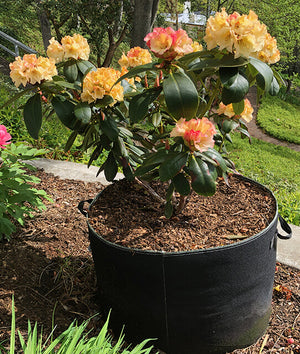
The Right Knife for the Job: The Best Knives to Use for These Everyday Tasks
If you don’t know too much about knives, you may very well think that you can use any old knife to do whatever you need in the kitchen. However, it’s not as simple as that, and for two very important reasons, you really should be using specific knives for particular tasks.
First, it’ll make your life easier and the whole process will be far more effective and efficient. And, second, using knives for their intended purpose will prevent them from breaking or getting damaged unnecessarily, and it’ll increase their lifespan. So, for both your sake and the sake of your knives (which can often be quite a financial investment), it’s essential that you make an effort to use the right knives for the right purposes.
But, it’s easier said than done. From the outset, having a collection of kitchen knives may seem simple, but if you’re not completely aware of what they’re made for, and can be overwhelming to decide which one is best for which occasion.
Well, luckily for you, we’re here to make your life a whole lot easier. We’re going to tell you exactly which knives to use in a plethora of different scenarios that you’re likely to come across in your kitchen, whether you’re an amateur home cook or somebody who’s hoping to get a little more serious about food.
Stick around while we give you a rundown of all the best knives to use for a variety of everyday tasks.
The Best Knife for: Filleting a Fish
If you’re going to be filleting fish, the best knife to use, unsurprisingly, is a filleting knife. It’s specifically designed for the purpose of removing fillets of fish from skin and being incredibly precise during the process.
A filleting knife has a long, slender blade that’s normally between six and eleven inches long, and the edge tapers towards a pointed tip. It’s super sharp, which allows them to be able to create precise cuts of fish and remove fillets from the skin without wasting meat while following the natural contours of the fish. They also have a little bit of flexibility to them which adds to their precision.
The Best Knife for: Deboning Meat
Deboning meat can be a reasonably difficult task and requires some precision, so it’s important that you use a boning knife in order to be as effective and efficient as possible.
A boning knife is quite long and narrow, much like a filleting knife, and on average, it’s between five and seven inches long. Another thing it has in common with a filleting knife is that it’s got some flexibility which adds to its ability to be incredibly precise.
It’s important to remember, however, that while a boning knife is intended for working with meat, it’s not meant to be used with bone or cartilage, despite its name. It’s supposed to be used to remove meat from the bone without actually coming into contact with it. It may be more rigid than a filleting knife, but it’s still a pretty delicate tool.
The Best Knife for: Chopping, Cutting, Slicing, and Dicing Vegetables
When it comes to working with vegetables, you have a couple of options, depending on what you have available to you and the size of the vegetable in question.
The easy answer is that a Santoku knife is generally regarded as the top, most specialized vegetable cutting knife, and for good reason. It’s similar to a chef’s knife, but the blade is a bit shorter, and it’s got a flat edge and a rounded tip. It also has a Granton edge – little oval-shaped divots on one side of the blade – which prevents the slices of vegetables from getting stuck to the knife.
A Santoku knife is also pretty light, so it may be ideal for people with small hands. It’s ideal for cutting, slicing, dicing, chopping, mincing, scooping, julienning, and precision work.
Another option that you’re likely to already have in your kitchen is the old favorite chef’s knife, one of the most versatile options available to you. It’s quite similar to a Santoku knife, but can also be used for meat and just about anything else you need to do. The blade is a bit longer and the knife as a whole is heavier too, so this would be good if you’re working with larger veggies or if you just have big hands.
If you’re working with small veggies, a utility knife is never a bad option – in fact, it can be great for small, slippery veggies on a slippery cutting board, especially if it’s serrated and you’re not a fan of big knives.
Finally, the least common option is a Nakiri knife, which is another kind of Japanese knife. It has a wide, broad blade.
The Best Knife for: Carving Meat
Meat carving requires both a lot of strength as well as a fair amount of precision, and a carving knife is specifically designed for this purpose. The blade is long, narrow, super sharp, and has a pointed tip, and a carving knife has also got some flexibility so that you can cut beautiful thin slices of meat.
The Best Knife for: Intricate Tasks
When it comes to precision and getting into intricate detail, the most important thing to consider is the size of the knife blade and whether or not it has a pointed tip. For these reasons, the best knife to use for intricate tasks is a paring knife. It’s small, sharp, it has a sharp pointed tip, and it’s easy to handle and maneuver.
A paring knife is excellent for things like deveining prawns, removing seeds, peeling, creating garnishes, or slicing something small like shallots.
Another knife that can be used for super precise tasks is a Japanese Sakimaru knife. The Sakimaru is way bigger than a paring knife – it has a long blade – but it’s also super sharp.
The Best Knife for: Breaking Down Large Pieces of Meat
A cleaver is the best and most effective tool to use to chop up and break down large pieces of meat, because it can cut through anything – meat, bone, cartilage, you name it. It’s strong, heavy, and the blade is large and wide.
Another option is a butcher knife, which shares both similarities and differences with a cleaver. While it’s also very strong and capable of cutting through bone and other tough materials, it’s not quite as heavy duty and it provides a little more precision.
So, if you’re just going to be breaking down a large piece of meat and don’t need to be specific or precise about it, a cleaver is probably what you want. However, if you need to work through bone, meat, cartilage, and more, but you want to do it precisely, we’d suggest a butcher knife – it’s still super strong, but has a longer and narrower blade.
The Best Knife for: Cutting and Working With Meat
If you’re planning on working with meat, either raw or cooked, you can go ahead and use a chef’s knife, since you don’t need anything particularly sharp or strong. Whether it’s raw chicken, seared steak, or cooked pork, a nice, sharp chef’s knife should do the trick.
The Best Knife for: Mincing Herbs
Mincing herbs can be done with a few different knives, depending on your preference, but the most common choice tends to be a chef’s knife. This is because it has some weight to it and it’s large, so you can scoop the minced herbs up onto the spine of blade too.
You can also use a trusty utility knife if you prefer the added control that it provides – it all depends on your preference and what you’re mincing.
The Best Knife for: Working with and Breaking Down Fish
The best knife to use for breaking down fish is a Deba knife, often referred to as a Japanese version of a boning or fileting knife, but it’s actually quite different. It’s a lot stronger and more sturdy than either of those, but it’s a bit more precise than a big cleaver or butcher knife – perfect for fish.
You can use a Deba knife to work with any kinds of fish, even very large ones, and break them down completely, through bones, fish heads, and more.
The Best Knife for: Cutting Up Very Large Fruit and Vegetables
We’ve already spoken about normal veggies, but sometimes, when you’re dealing with something large like a pumpkin, butternut, or watermelon, an ordinary knife isn’t going to work. We’d still recommend a chef’s knife or a Santoku knife, but you can also use a carving knife if you’d prefer. The length the blade can help you cut right through.
The Best Knife for: Making Sushi
When you’re making sushi, you need to be able to produce thin, precise slices of fish, and a sashimi knife is certainly the best option for that. The blade is incredibly sharp, with a single-sided bevel, and it’s also super long and quite narrow.
Another option is a Kiritsuke knife, which is often described as a mixture between a sashimi knife and a Santoku knife. But, at the end of the day, a sashimi knife is always the first choice for sushi and sashimi.
The Best Knife for: Cutting Bread
This one’s pretty obvious, but just in case it needs to be said, a bread knife is the best thing you can use for cutting and slicing all types of bread. It’s serration and long blade allow the blade to grip the crust and cut all the way through in a back-and-forth motion.
If you have small, thin bread rolls or bread sticks, you could also use a serrated utility knife, but a bread knife is almost always the way to go.
The Best Knife for: Cutting and Slicing Cheese
Slicing cheese isn’t necessarily as simple as you may think, and if you want to do it properly – especially if you’re serving a platter – you’d be interested to know that there are actually different types of cheese knives for different types of cheese.
For hard cheeses, you tend to use cheese knives with sharp, wide blades, and for soft or crumbly cheese, knives that have smaller blades, forked tips, and a granton edge are preferable. That’s because soft cheese is more likely to stick to the blade.


